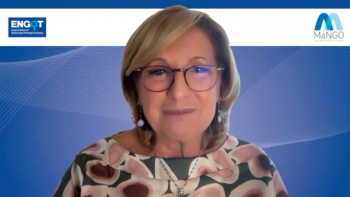
Patient Centricity of Care Delivery and Payment Models
Brenton Fargnoli, MD: I think a lot of these alternative payment models have specific requirements that engender certain aspects of patient-centeredness. For example, the Oncology Care Model requires a care plan—13 points documenting the treatment, the goals, and the expected response. [The care plan] is to be provided to that patient and [practices need] to make sure they have a document that [patients] can understand, [that’s written] in patient-centered language. There are quality measures around patient satisfaction and shared decision making such as percentages of advanced care plans documented. Again, these are specific aspects, certainly not the whole picture. And I think to get to the whole picture and really [put] the patient at the center of it turns into [being aware of] how the patient is really a central piece of physicians taking on risk—patients knowing where to call when they’re having trouble; patients really engaged and educated about their care.
There aren’t as many specific requirements around that, and I think practices, together, are going to come up with a solution on how best to engage them (patients)—whether that’s through text messages, or apps, or phone calls, or programs, and other ways to really engage them in that care with the ultimate shared goal of avoiding an unnecessary hospitalization or an unnecessary kind of decrement in their health. But that piece of shared savings is a lot more nebulous than an actual percentage of patients getting this [outcome].
Rena M. Conti, PhD: And I would argue that the biggest potential way of managing a lot of the risk of these patients is just by keeping them out of the hospital. No matter your flavor of alternative payment method, that choice of trying to keep patients out of the hospital is going to be front and center of any practice doing this over the next 5 years.
Andrew L. Pecora, MD, CPE: I agree. I’d like to [add] that we’ve had enough experience now where we’ve been able to change the behaviors of payers because of the level of data that we’re able to acquire. And that is the biggest tragedy—someone not getting the right care, having the wrong outcome. And, believe it or not, it actually costs more money.
So we’ve been able to change, without getting into specific details, reimbursement policies of major payers because by spending a little bit of money up front, they get a “10Xreturn downstream. In one example, women are found to not need chemotherapy. [For those] who were getting it, now they don’t. And, in another example, people were getting very toxic medications when they could get [much] less toxic, and highly more effective, medications, and live 4 times longer. So my personal view, as a practicing cancer doctor and as a researcher, is that this is a wonderful transition from anarchy, where variance reigns, to reigning in variance, to moving to precision.
The president deserves a lot of credit for the emphasis he put on precision medicine. In precision medicine, when you think about solving the “N-of-1” problem (population health), you do the same thing, pretty much, for a big population—not accounting for the variability [from] person to person. And you get it [right] about 80% of the time. [With] precision medicine—if you’re really good at it, you get it right all the time. Then you add it all up and you have the “N-of-1” problem solved. Yet, you’ve done the same thing as you try to do in population health. So what’s going to change this entire dialogue? It’s going to make regulators and payers crazy that we’re just starting to get our head around all the things we just talked about, and it’s going to move to the right again with immuno-oncology, genomics, proteomics, and other things. It’s just an incredible time.
Let’s jump back over to Dr Sagar and get her take.
Bhuvana Sagar, MD: Are existing alternative payment models patient-centered or not? Definitely. I think we’ve all gotten away from the fee-for-service world with the Institute of Medicine report coming out. In talking about how disjointed care has been—I think a lot of us have taken a look at that and have wanted to bring the patient back to the center [by] trying to make sure that care is integrated and coordinated completely. It’s not just about getting evidence-based medicine, although that is a huge component of it. We want to make sure that patients are getting a NCCN [National Comprehensive Cancer Network] guidelines-based approach for their treatments as much as possible. There might be variations and we understand that. But for the most part, we want to focus on evidence-based medicine, and we also want to make sure that the patient’s voice is heard as much as possible.
Our model—we’ve tried to keep it as simple as possible for a reason. We don’t want to mandate too many things. We don’t want to regulate too many things. We want to give the provider a certain amount of freedom to be able to take care of their patient as well as they can. So the whole model is centered around the patient, but we want to encourage that physician-patient interaction and build on that relationship.
Newsletter
Stay ahead of policy, cost, and value—subscribe to AJMC for expert insights at the intersection of clinical care and health economics.















































